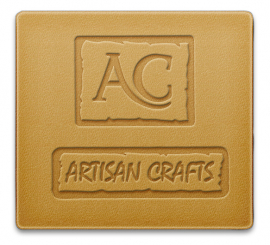
Here's just a few of my recent bindings:
A Book of Notes
3 piece hardback with 2 bookcloths, headband, inset printed label and printed endpapers.
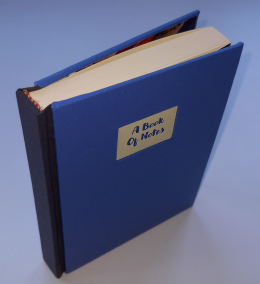
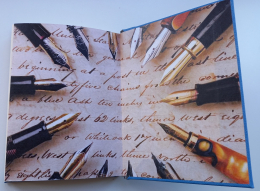
Fold-Back Sketchbook
Fold-back sketch book with flexible spine. A link stitch was included for extra strength, as well as encircling the tapes. Checkout the funky endpaper.
This has a soft canvas spine cloth that will take the excessive folding. Paper is a lovely creamy soft Zerkal.
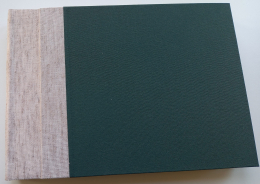
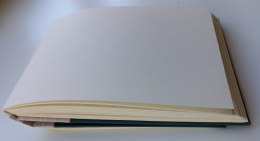
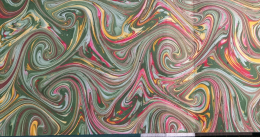
Coptic Stitch binding.
Coptic stitch - case has very small squares as the sections will move when opening. 170 gsm Stockwell paper in cream, endpaper with square motif (that was fun trying to keep it centred!). Larger 18/3 thread used to make more of a feature of the stitching.
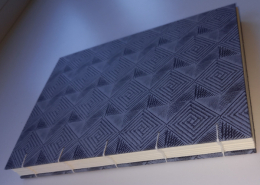
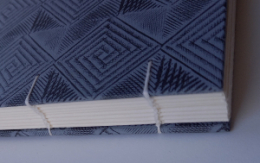
Note & Sketch Books
Notebooks can come in many shapes and sizes. But which one works best for you?
We've all been there - browsing in the stationers, or nowadays more likely Pinterest, looking for the design that feels right for you.
Well now you can have your ideal notebook or sketchbook designed exactly how you want it (within reason i.e. within the bounds of material I can source!).
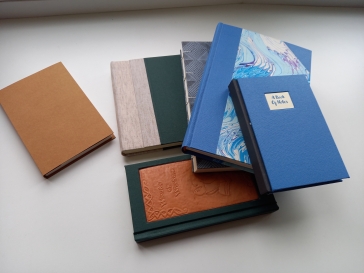
What choices are there?
Most of these designs will be hardback - if you want a soft cover see the Journals section.
Size:
Most folks go for a standard ISO size e.g. A5/6/7. However when making a new design from scratch there are less limitations given that I buy the papers in sheets of A1 (841mm x 594mm).
Orientation:
Portrait or landscape or square - makes no difference to me which way round I make it.
Paper type:
Some folks can get real fussy about their papers - my default paper is Stockwell from John Purcell, which has a nice tooth for drawing, will hold watercolour well and doesn't bleed when using fountain pens.
BUT there are so many types of paper available - too many to mention here so just let me know what you prefer. For instance the G.F.Smith sample book alone is 4 inches thick and contains 450 types of paper!
What you choose depends on what you want to put on the paper.
Covering:
The covering needs to stand up to the level of wear & tear you put the book through, as well as look pleasing to the eye.
Generally this means some sort of bookcloth which comes in a wide range of colours and finishes. J. Hewit & Ratchfords are my default suppliers - see their ranges by clicking on the links in their names.
But you don't have to stick with cloth - as long as it can be cut & folded and glued it can be used. For instance, the second book down in the picture above is half-bound in bookcloth and hand-marbled paper I've made myself. I've been collecting bark from a silver birch tree in my garden which I'm going to try some day.
Spine type:
The majority of notebooks have flat spines, with a single sheet of cloth covering them.
They can come in a 3 piece design as in the top notebook in the picture above.
I have also designed a hardback sketchbook which can fold right over like a spiral-bound book.
If you want something a little different, there is the coptic stitch design in which the stitching is exposed - using coloured thread can make this an attractive feature.
For specialist work to bind picture sets or rare drawings, there are numerous stub binding techniques that work well here.
Endpapers:
Endpapers are what you see when you first open the book. Their main job is to form the internal hinge and to cover up all of the messy bits that attach the case to the book block.
They can be plain or patterned, or printed to a specific design that complements the book content. There is even a Facebook page dedicated to endpapers.
Labels:
It's nice to have a label on a book - whether it is on the spine or the front.
This can be printed and glued into a window, or it can be tooled in gold if you really want to push the boat out! The book on top of the pile above shows an example - "A Book of Notes".
Get in touch
I don't have a shop front set upon my website just yet, so go to the contacts page and send me an email & I'll respond as soon as I can. Most items can be made in a few hours so delivery just depends how much work I have on.




